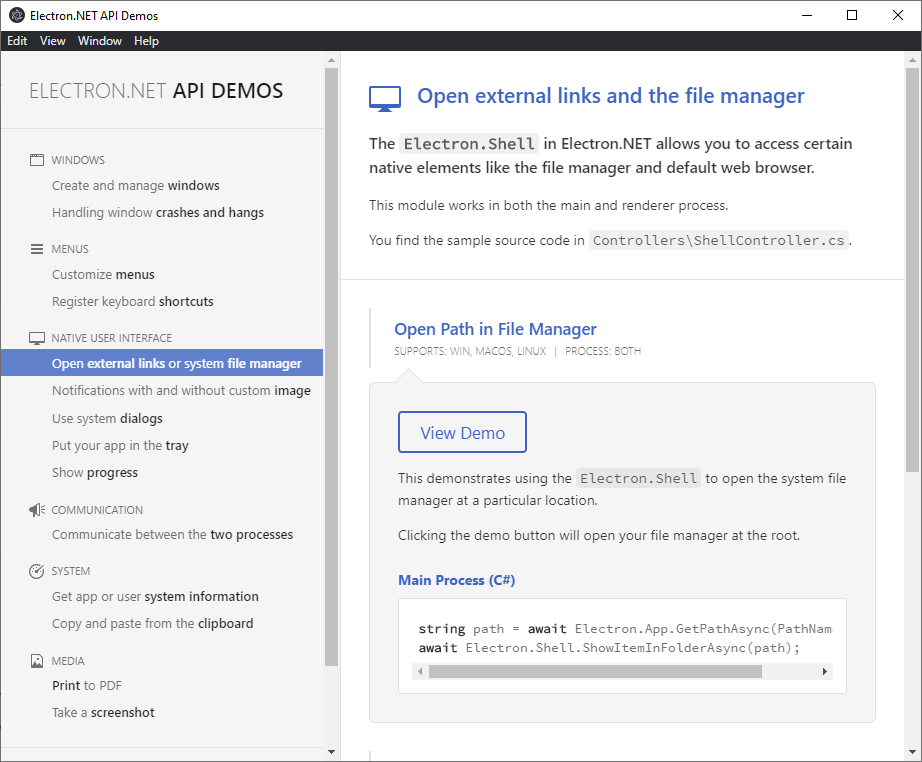

- #Electron api how to#
- #Electron api install#
- #Electron api full#
- #Electron api code#
- #Electron api mac#
Calls the native elements Opening dialogs and other native operating system interactions are resource-intensive, so it’s done in the main process, leaving the renderer process uninterrupted.It also calls the native elements and creates each new renderer process in the app. It controls the life of the app, from open to close. The main process, commonly a file named main.js, is the entry point to every Electron app. For instance, the dialog module has all the APIs for native dialogs like open file, save the file, and alerts. Modules Electron’s APIs are grouped based on what they do.The main process is more behind-the-scenes, while the renderer process is each of the windows in your app. There are modules that work on each or in both of the processes. Mozilla Developer Network (like a dictionary for websites and JavaScript)Įlectron has two types of processes: Main and Renderer.CSS Tricks (learn CSS best practices and tips).
#Electron api code#
Learn to Code HTML & CSS (by Shay Howe).

#Electron api install#
Check out some tutorials on HTML, CSS, and JS and install Node on your computer. Since Electron’s two components are websites and JavaScript, you’ll need experience in both of those before you begin.
#Electron api full#
Use Node in That’s not all! In addition to the full Node API everywhere, you can make use of the over 300,000 modules already written and hosted on npm, a package manager for Node.And you only need to design for one browser, the latest Chrome. Electron blog post: Using Node as a Library (deep dive)ĭeveloping with Electron is like building web pages that you can seamlessly use Node in-or building a Node app in which you can build an interface with HTML and CSS.Node.js (or Node) A tool for writing JavaScript on servers, accessing filesystems, and networks (your computer is also a server!).Chromium Created by Google, this is the open-source library used by Google’s browser Chrome.API Application Program Interface describes the set of functions made available for you to use a library with.Next: What is developing like? Definitions: native (operating system) language These are languages that the major operating systems are (mostly) built with: Mac, Objective C, Linux, C Windows, C++.Įlectron combines Chromium and Node.js with a set of custom APIs for native operating system functions like open file dialogs, notifications, icons and more.Electron enables you to write your app once and with web languages. That can mean having three teams writing three versions of your app. Typically, desktop applications for each operating system are written in each’s native language. Electron API Demos (see what you can do with Electron).You use it to build your project on top of it. Electron is a library Electron is code that you can re-use and not have to write yourself.
#Electron api how to#
#Electron api mac#
These applications can be packaged to run on Mac, Windows and Linux computers as well as be placed in the Mac and Windows app stores. BackgroundĮlectron is a library you can use to build desktop applications with JavaScript, HTML and CSS. Here is an excellent write-up by Jessica Lord: Essential ElectronĬoncise plain-speak about Electron. A lot of them are listed at or can be found here.

Instead of always “re-inventing” the wheel, we can take advantage of all sorts of open-source libraries, packages, and tools. Because it uses web technologies, you can build desktop applications with HTML, CSS, and JavaScript, which means it works cross-platform on Mac, Windows, and Linux. So why electron? Electron is an open-source project maintained by GitHub and based on Node.js and Chromium. Building pipeline tools in the past - at least for me - involved dealing with Qt.


 0 kommentar(er)
0 kommentar(er)
